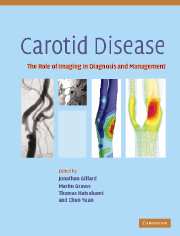Book contents
- Frontmatter
- Contents
- List of contributors
- List of abbreviations
- Introduction
- Background
- Luminal imaging techniques
- Morphological plaque imaging
- Functional plaque imaging
- Plaque modelling
- Monitoring the local and distal effects of carotid interventions
- 25 Transcranial Doppler monitoring
- 26 Imaging carotid disease: MR and CT perfusion
- 27 Near infrared spectroscopy in carotid endarterectomy
- 28 Single photon emission computed tomography (SPECT)
- 29 Monitoring carotid interventions with xenon CT
- Monitoring pharmaceutical interventions
- Future directions in carotid plaque imaging
- Index
- References
26 - Imaging carotid disease: MR and CT perfusion
from Monitoring the local and distal effects of carotid interventions
Published online by Cambridge University Press: 03 December 2009
- Frontmatter
- Contents
- List of contributors
- List of abbreviations
- Introduction
- Background
- Luminal imaging techniques
- Morphological plaque imaging
- Functional plaque imaging
- Plaque modelling
- Monitoring the local and distal effects of carotid interventions
- 25 Transcranial Doppler monitoring
- 26 Imaging carotid disease: MR and CT perfusion
- 27 Near infrared spectroscopy in carotid endarterectomy
- 28 Single photon emission computed tomography (SPECT)
- 29 Monitoring carotid interventions with xenon CT
- Monitoring pharmaceutical interventions
- Future directions in carotid plaque imaging
- Index
- References
Summary
Introduction
The presence of adequate cerebral circulation is important to maintain cerebral perfusion and brain function in patients with severe carotid artery disease (Powers, 1991; Klijn et al., 1997; Caplan and Hennerici, 1998; Derdeyn et al., 1999). The level of cerebral perfusion is influenced by many factors such as degree of ipsilateral stenosis, degree of contralateral stenosis, capacity of posterior circulation, the anatomical variants and completeness of the circle of Willis, the remaining vasomotor reactivity, which on itself is influenced by underlying pathology such as atherosclerosis or inflammatory processes, and capacity to reroute blood flow, for instance, via leptomeningeal anastomoses. Although Liebeskind correctly mentioned that the understanding of the cerebral circulation is improved by determining the extra- and intra-cranial collateral capacity (Liebeskind, 2003), the large number of confounding factors, mentioned above, makes it virtually impossible to predict which patients with carotid artery disease are at (high) risk for recurrent symptoms caused by hemodynamical factors. It has been shown that in patients with symptomatic severe internal carotid artery (ICA) stenosis carotid endarterectomy reduces the risk of recurrent stroke by removal of the atheromatous plaque (European Carotid Surgery Trialists' Collaborative Group, 1991; NASCET, 1991; Barnett et al., 2000). Although in patients with occlusive disease of the ICA, the cause of stroke is primarily thromboembolic, the presence of hemodynamic impairment is also recognized as additional risk factor (Caplan and Hennerici, 1998; Grubb et al., 1998).
Keywords
- Type
- Chapter
- Information
- Carotid DiseaseThe Role of Imaging in Diagnosis and Management, pp. 358 - 371Publisher: Cambridge University PressPrint publication year: 2006



